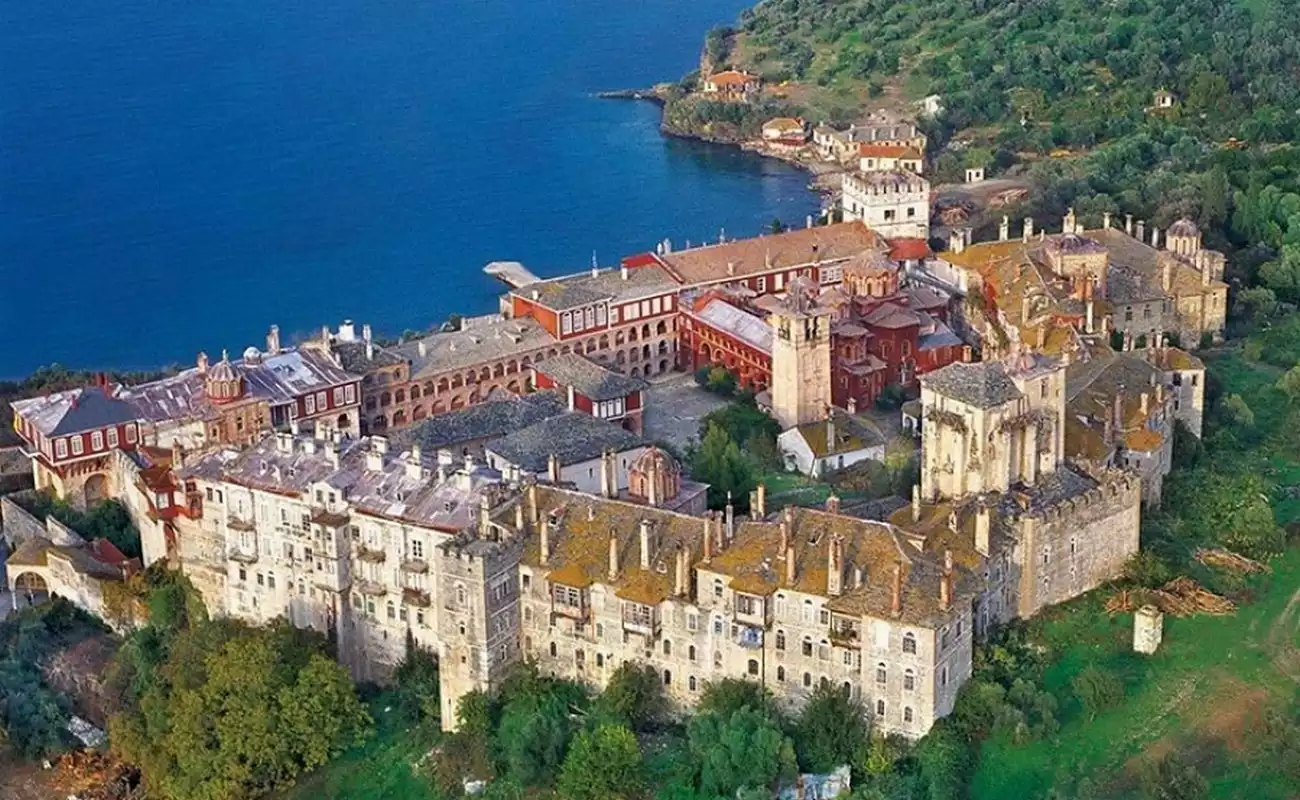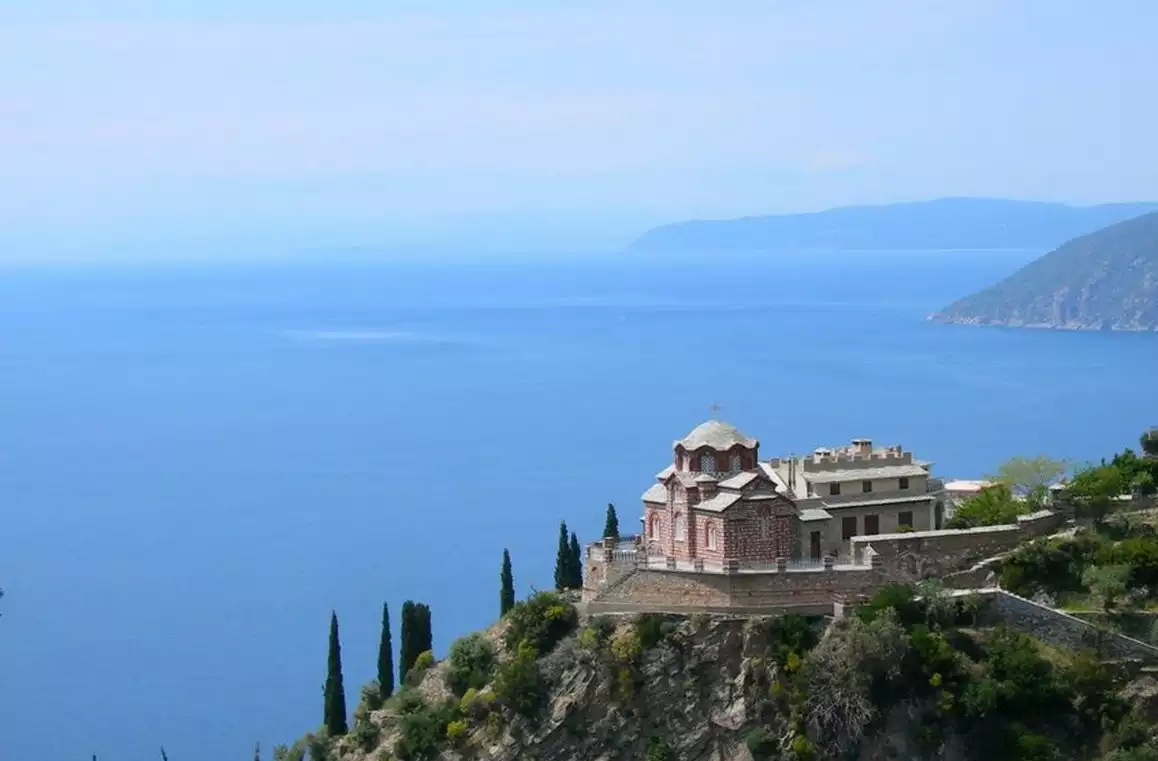Mount Athos, a monastic peninsula in northeastern Greece, stands as a beacon of Orthodox monasticism. With its rich history and spiritual significance, it remains a unique religious enclave, epitomizing a place of solitude, prayer, and spiritual pursuit. This sacred site, steeped in centuries of monastic traditions and deep religious devotion, is where monks dedicate their lives entirely to God. It’s a revered sanctuary offering a profound connection with the divine, characterized by its ancient monasteries and serene natural beauty, untouched by the temporal world.
Etymological Analysis
The name ‘Athos’ is believed to derive from an ancient Greek myth, wherein a giant named Athos threw a massive rock at Poseidon, which then formed the mountain. However, Mount Athos holds no explicit biblical references. Its typological significance lies in its embodiment of Christian monastic ideals – a living testament to the quest for spiritual purity and solitude.

Historical Genesis of Mount Athos
The history of Mount Athos is a tapestry of faith and devotion. Established in the early Christian era, it became a flourishing center of Orthodox monasticism by the 10th century. Emperors and nobles, struck by its spiritual aura, endowed it with riches and privileges. The Athonite community, governed by the ‘Athonite Typikon’, a set of monastic rules, grew to encompass 20 major monasteries and numerous sketes (smaller monastic communities).
Mount Athos’ historical journey is marked by its resilience. Despite periods of decline and external threats, including raids and political upheaval, it persevered as a spiritual haven. The Byzantine era saw its zenith, with monks from across the Orthodox world seeking solace and spiritual growth within its confines.
By the 14th century, Mount Athos had established itself as a center of theological scholarship and Byzantine art. Its libraries became repositories of ancient texts, preserving the rich heritage of Christian Orthodoxy. The monastic community, though isolated, contributed significantly to the spiritual and cultural life of the Orthodox world.
Mount Athos’ historical significance extends beyond its religious aspect. Its unique political status, as an autonomous monastic state within the Hellenic Republic, is a testament to its enduring legacy and the respect it commands. The ‘Holy Mountain’, as it is reverently called, remains an emblem of the enduring power of faith and tradition in the modern world.
Architectural and Artistic Heritage of Mount Athos
Mount Athos, steeped in centuries of history, showcases a rich architectural and artistic heritage. The monasteries, each a fortress-like complex, stand as masterpieces of Byzantine architecture. Their construction, often perched on cliffs or nestled in verdant valleys, reflects a harmony between spiritual pursuit and nature’s majesty.
The architecture of these monasteries, characterized by imposing walls and high towers, served a dual purpose: fostering spiritual solitude and offering protection against invasions. Within these walls, the layout typically features a central church or ‘katholikon’, surrounded by chapels, monastic cells, refectories, and libraries. The katholikons, adorned with intricate frescoes and mosaics, are the focal points of liturgical life, encapsulating the essence of Byzantine art.
Frescoes and icons in Mount Athos bear witness to the evolution of Orthodox Christian art. These visual narratives, steeped in religious symbolism, portray scenes from the Bible and the lives of saints. The unique Athonite style, developed over centuries, blends spiritual depth with artistic excellence, creating an ambiance of contemplative beauty.
The iconography of Mount Athos, renowned worldwide, is more than art; it is a medium of theological expression. The icons, crafted with meticulous care, are not mere representations but are considered windows to the divine. They play a crucial role in Orthodox worship and spirituality, embodying the mystical and transcendental aspects of the faith.
Mount Athos’ contribution to Christian art extends to manuscript illumination and ecclesiastical embroidery. The monastic libraries safeguard a treasure trove of illuminated manuscripts, each a testament to the monks’ dedication to preserving religious texts and their artistic embellishment.
The artistic heritage of Mount Athos, thus, is not only a reflection of its historical and spiritual journey but also a living tradition that continues to inspire and elevate the human spirit in the pursuit of the divine.

Spiritual and Cultural Impact of Mount Athos
The spiritual and cultural impact of Mount Athos resonates far beyond its physical boundaries. As a center of Eastern Orthodox monasticism, it has profoundly influenced Christian spirituality, theological thought, and cultural traditions. The monastic life on Mount Athos, centered around prayer, meditation, and communal living, exemplifies the pursuit of spiritual perfection and detachment from worldly distractions.
The Athonite monks, through their ascetic practices and scholarly pursuits, have contributed significantly to Orthodox theology. Their writings, homilies, and philosophical treatises address fundamental questions of faith, ethics, and human existence. The spiritual teachings emanating from Mount Athos emphasize humility, compassion, and the transformative power of divine grace.
Mount Athos has also played a crucial role in preserving Orthodox traditions and customs. The liturgical practices, hymnography, and ritual art developed here have enriched the broader Orthodox Christian worship. The Athonite monastic calendar, with its cycle of feasts and fasts, marks the rhythm of religious life, influencing Orthodox communities globally.
The cultural contributions of Mount Athos extend to education and the arts. The monastic schools have nurtured generations of scholars, theologians, and artists, who have disseminated their knowledge and skills across the Orthodox world. The artistic techniques and styles developed on Mount Athos have influenced Orthodox iconography and church architecture across continents.
In contemporary times, Mount Athos continues to be a beacon of spirituality and a repository of Christian heritage. Its monasteries, libraries, and art treasures are not only of religious significance but also of immense historical and cultural value. The Holy Mountain remains a living monument to the enduring legacy of Orthodox monasticism and its role in shaping the spiritual landscape of Christianity.

Mount Athos, with its centuries-old monasteries, enduring spiritual traditions, and rich cultural legacy, stands as a testament to the profound influence of monasticism on Christian history and civilization. Its enduring presence is a symbol of the timeless quest for spiritual depth and understanding in a rapidly changing world.
References
- Academia.edu. “Russian Research Work in the Archives of Mount Athos.” Accessed December 31, 2023. Academia.edu.
- Angelopoulos, A. (2018). “Mount Athos: A History of Monasticism.” Athens: Heraklion Press.
- Davies, J. (2020). “Byzantine Art and Architecture: An Athonite Perspective.” London: Oxford University Press.
- De Gruyter. “Orthodoxy and Psychotherapy.” Accessed December 31, 2023. De Gruyter.
- Gregoriou, N. (2016). “The Theology of Mount Athos.” Thessaloniki: Patristic Publications.
- Hatzidakis, M. (2017). “Icons of Mount Athos.” Athens: Byzantine Museum.
- Journal of Conservation and Museum Studies. “Mount Athos: A Case Study in Cultural Heritage Conservation.” Accessed December 31, 2023. Journal of Conservation and Museum Studies.
- Kallistos, B. (2019). “Monastic Wisdom: The Letters of Elder Joseph the Hesychast.” Mount Athos: Holy Monastery of St. Paul.
- Makarios, H. (2015). “Mount Athos: The Spiritual Heart of the Orthodox World.” New York: St. Vladimir’s Seminary Press.
- Papachrysostomou, A. (2021). “Orthodox Spirituality and Athonite Heritage.” London: Faith Press.
- Simonopetra Monastery. (2014). The Athonite Typikon: Monastic Life on Mount Athos.” Mount Athos: Simonopetra Monastery.
- Ware, T. (2022). The Orthodox Church: An Introduction to its History, Doctrine, and Spiritual Culture.” New York: Penguin Books.

